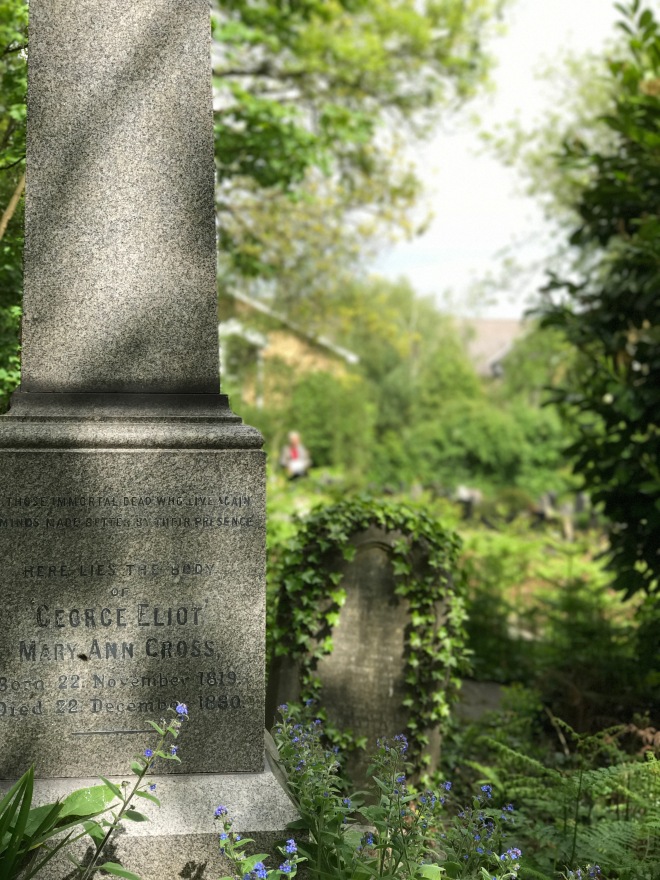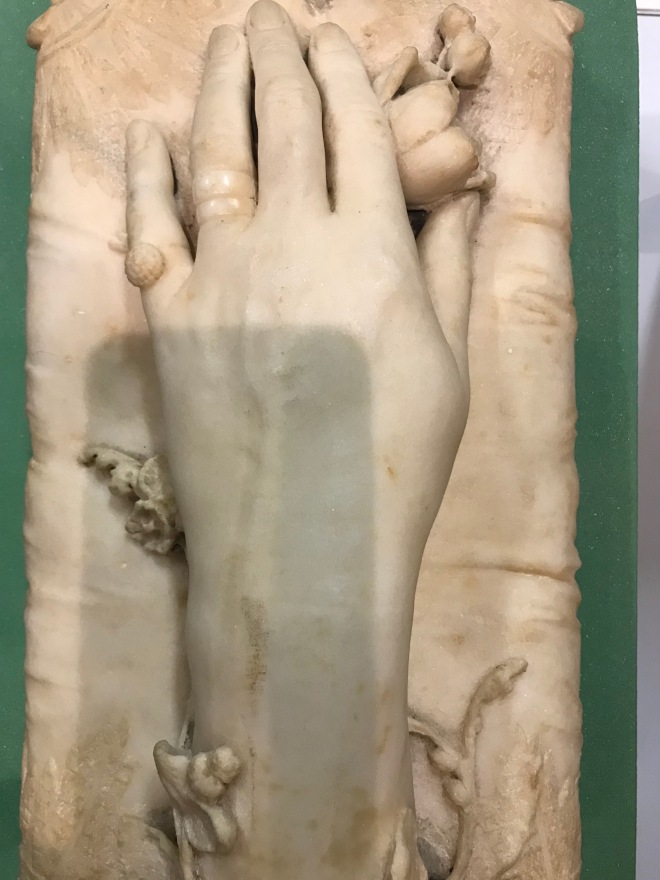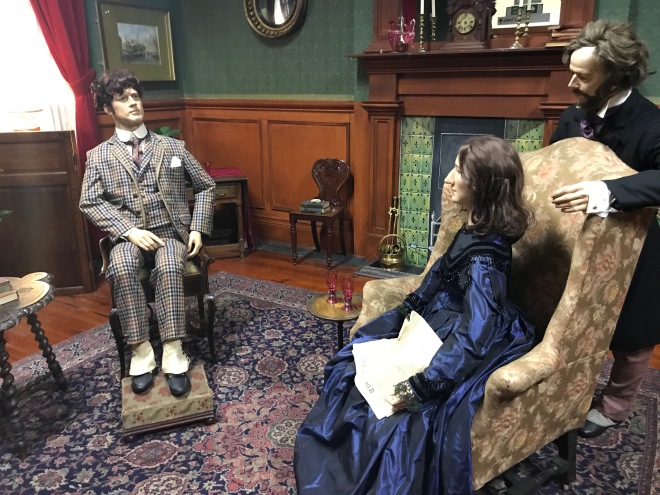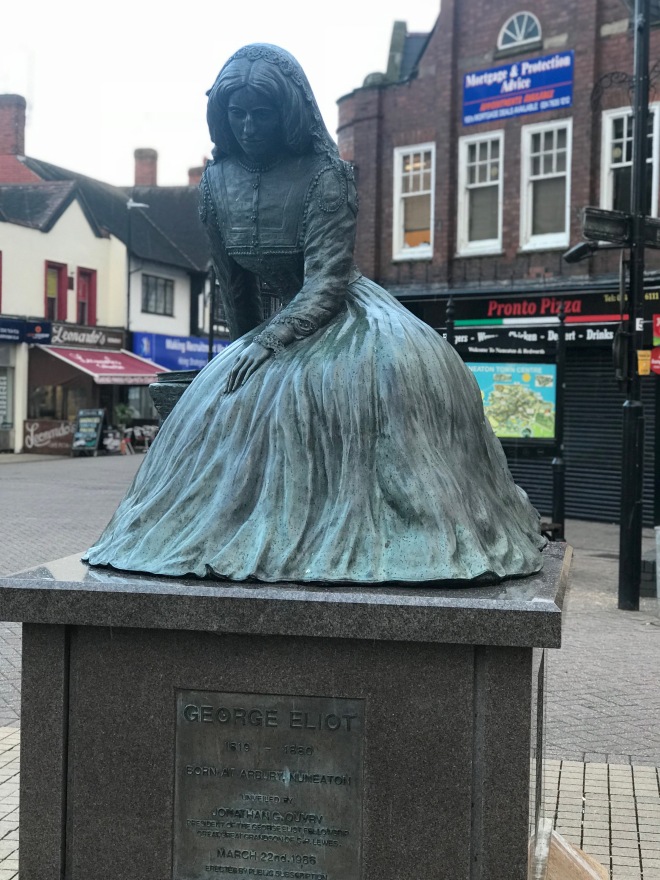Last semester, I enjoyed teaching a new 12-week module on Elizabeth Gaskell and the Brontës. The module covered the Brontë juvenilia and a number of novels in addition to literary, stage, and cinematic adaptations. After having discussed adaptation theory and having completed a formative analysis of the 2016 BBC film, To Walk Invisible, students were asked to post to Canvas two summative 500-word discussion-board pieces on selected adaptations for 20% of their final grade. Please read on to see a selection of the excellent work that was produced through the semester.
To see the adaptations discussed through the module, take a look at the Box of Broadcasts list here.
Review of Jane Eyre (2011 film. Dir: Cary Fukunaga) by Catherine Hall
The simple and authentic-looking costumes in Jane Eyre, the 2011 adaptation by Cary Fukunaga, were designed by Michael O’Connor. Fukunaga used these costumes and in particular, scenes of undressing, to both mark key elements of plot and to show the development of Jane’s character.
The first instance of this is shown at Lowood School where Jane is undressed out of her smart gown. In chapter 5 of the novel, Jane comments: “To-night I was to be Miss Miller’s bed-fellow; she helped me to undress.” Miss Miller’s kind and almost sympathetic nature to the new young girl mirrors that of a nurse or mother, and so the undressing appears a simple routine. However, in the 2011 adaptation, it is Miss Scatcherd who briskly undresses Jane, looking almost in distaste at her gown and commanding her to “step out of your fine dress”. Jane is compliant, and the zoomed-in camera shot of her stepping out illustrates her stepping into her new life at Lowood. Jane is also left alone in her white undergarments and, again, the camera allows us an insight into her isolation and the humiliating nature of the undressing by panning out to a view of the rest of the dormitory with the other girls looking towards her. I agree with Emma’s comment above that “Fukunaga has used the camera… to manipulate the audience” as here we feel pity due to the zoom out and isolation of Jane.
The second poignant scene of undressing takes place when Jane arrives at Thornfield. In chapter 11, Jane describes how Mrs Fairfax “conducted me to her own chair, and then began to remove my shawl and untie my bonnet strings: I begged she would not give herself so much trouble”. This marks a change from a child being undressed at Lowood, to a young adult by her embarrassment of being aided. In the adaptation, the scene also shows Jane’s change in status, due to the servants and Mrs Fairfax waiting on Jane. Thus, Fukunaga shows the development of Jane’s character from childhood by another scene of undressing, and also introduces the kind, almost familial figure of Mrs Fairfax.
Tim Robey, in his review for The Telegraph, comments: “Fukunaga’s delicate artistry leaves it hard to ask for much more”. I agree with Robey, as there are some moments of beautiful stillness that allow reflection on the development of Jane’s character. For instance, when Jane hurriedly takes off her wedding dress, the action pauses as Jane looks at herself in the mirror in her under-dress. I was instantly reminded of the young Jane standing alone after being undressed from her fine gown at Lowood. She mirrors the same expression of sadness and to some extent, humiliation as she looks at herself and the wedding dress on the floor. Therefore, this final scene of undressing, acts as a pause from the fast-paced action, and a reflection of Jane’s innocence and isolation as first shown at Lowood.
Review of Wuthering Heights (2011 film. Dir Andrea Arnold) by Hannah Cox
Arnold’s adaptation of Wuthering Heights saw animals being used for symbolic imagery in relation to the characters. With the removal of Nelly Dean as the diegetic narrator, the film takes on Heathcliff’s perspective. Our first encounter with Heathcliff shows him growling at the dogs and unable to communicate in English. As he is forced to serve under Hindley in order to remain with Cathy, he is degraded to be like the animals, being forced to sleep on the floor “like the animal [he is]” (Hindley). Peter Bradshaw states in his review that ” the gap between human and beast is narrowed” in this film. Seeing Heathcliff’s sadness and frustration at being treated like an animal, helps us to understand why he returns in such an inhuman state, when the only human compassion he has is taken away from him.
Animals in the film rarely escape death. Early on, we get a tracking shot showing two white geese ascending a lane together. This mirrors the no-stabilizer tracking shots of Heathcliff and Catherine on the moors. Later, Nelly holds one of the geese upside down, dead and being plucked, mirroring Heathcliff as he takes his first wash as a servant and being separated from Catherine – his reason for living. The remaining white goose could represent Catherine as she climbs the social ladder and marries into the Linton family, as the Linton’s associate themselves with only white horses and dogs and Catherine is repeatedly mirrored by bird symbolism. Moths also represent death, as two bright yellow moths sit on the windowsill of the Heights, but later reappear during Mr Earnshaw’s death as white. The same happens again when Hindley is ill, as a white moth appears signifying his approaching death.
At the Linton’s, a yellow canary bird is singing in its cage. Nearing Catherine’s death, the bird is seen again with its shadow prominent against the wall, the sunset casting it’s light and signifying the end of Cathy and her being trapped in a marriage she did not wholly want. A feather is used as Catherine’s bookmark and, through it, we see her story being stopped and her life ended. Cathy’s death is followed by a view of Heathcliff on the moors. An analeptic moment reveals Catherine showing him her favourite feather, and then a panoramic shot reveals a bird dropping a feather and flying away: a symbol that he was truly loved, and that Catherine is free.
The animals emphasise the presence of death. Heathcliff kills animals on screen with very little emotion. With such an emphasis on Heathcliff, the film effectively shows how death had little significance for him, and how Catherine is the only being of any importance to him. Having been treated like an animal, he desires revenge for being degraded and deemed unsuitable for marriage by Catherine. Animals have no general significance for him, except for the birds, which symbolise Catherine and remain to the end the animal she herself shows most appreciation for. This vicarious appreciation again demonstrates Heathcliff’s love for Catherine, the only person of any significance from his perspective.
Review of Wuthering Heights (2011 film. Dir Andrea Arnold) by Raj Mann
Following on from the important point that Hannah made in her discussion that this adaptation eschews the diegetic narration that is in the novel, I shall be exploring the ways in which Andrea Arnold represents the character of Heathcliff during one scene. In comparison to Emily Brontë who represents Heathcliff in both mimetic and diegetic ways, Arnold shows us rather than tells us. This difference in representation of the same character could be linked to the Linda Hutcheon quote that Jessica acknowledged in her discussion: “adaptation is a form of repetition without replication” (2013, pxiii). I shall be focusing on the scene commencing around 1:29:27.
Whilst in the novel we are told that: “It’s surely no great cause of alarm that Heathcliff should take a moonlight saunter on the moors, or even lie, too sulky to speak to us, in the hay-loft” (2009, p74), also that he is “rather morose” (2009, p3) and a “miserable, degraded character” (2009, p101), we are never actually shown Heathcliff in one of his supposed ill-humours alone on the moors. In this adaptation, however, Arnold elaborates on the novel by showing us this. The establishing shot of the scene, a long-shot of the moors looking eerily dark and gloomy, instantly works towards creating a sombre tone. This is partly due to the exact same establishing shot being used earlier (46:00) after Heathcliff is told by Hindley that he cannot talk to Cathy again without his permission or else he shall be dismissed. The only differences are that the sky is now even darker and that there are no birds flying. As the darkness from the sky and empty moors fill the frame, the fact that the frame is a long-shot makes the darkness and sense of emptiness seem all the more pervasive and large. Moreover, the use of sound in this shot has a subtly effective quality. As Béla Balázs outlines: “Silence, too, is an acoustic effect, but only where sounds can be heard. The presentation of silence is one of the most specific dramatic effects of the sound film. No other art can reproduce silence.” (1972, p205). The faint sound of the wind blowing whilst we are presented with the long-shot of the daunting moors draws our attention to the prior silence in the same shot. Significantly, the wind here creates only a tiny, faint sound and is therefore not prominent enough to disrupt the wider sense of silence. This empty sense of sound, accumulated with the vast, desolate and gloomy image of the moors, might connote a sense of emptiness to the viewer.
The sombre tone that the initial shot begins to create comes into full fruition following the next shot. In the next shot, we see Heathcliff lying down on a moor in the dark fog from a high angle long-shot. The high angle shot reflects Heathcliff in a rather vulnerable and pathetic way, especially as he is lying down with his body spread out. The long-shot, conversely, further aligns Heathcliff with the pervasive, frame-filling darkness and emptiness that was rife throughout the initial shot. It also reflects him in contrast to the wider picture, making him seem more alone. This then affects what James Monaco would call the “syntagmatic connotation” (2009, p181) of the initial static moor shot. Looked at in relation to the following shot of Heathcliff lying down alone in the fog, the moor shot seems to have not only contributed towards creating a sombre tone, but also to have vicariously represented the darkness and emptiness that Heathcliff is evidently feeling.
Bibliography:
Balázs, B (1972) Theory of the film. New York: Arno Press.
Brontë, E (2009) Wuthering Heights. New York: Oxford University Press.
Hutcheon, L. and O’Flynn, S., 2013. A theory of adaptation. 2nd ed. New York: Routledge.
Monaco, J (2009) How to read a film. Oxford: Oxford University Press.
Review of North and South (2004 4-part TV mini-series; Dir Brian Percival) by Kaileb Bryant
I will be investigating the episode where the Hales embark on their journey to Milton and analysing how Milton starkly contrasts with the countryside. I argue through using visual and aural representation, Brian Percival amplifies the social divide Gaskell implemented in North and South between country people and townsfolk.
Amber Topping asserts “North and South, in fact, is visually quite stunning […] the production design [is] artistic”. Percival’s “artistic” judgement to include this additional train carriage scene shows a beautiful, green, countryside view from the windows, ready to juxtapose with the city scenes. The carriage is well lit, full of rich colours, the vibrancy connoting joy; with the gentle sounds of the train moving over the tracks implying the country’s tender characteristics. Hopefulness transpires from Margaret with “we’ll stay at a hotel until we find a house, it won’t take long” (0.09-0.13) which her father then reiterates (0:23 – 0:25). Her tonality is sincere, genuinely believing this. The ironic last words spoken in this scene are from Margaret who says, “We will manage, mother. It’s not another planet!” (0.43-0.46). The green trees behind her as she speaks firmly place them as countryside people, accentuating the divide between country and city, different “planet[s]”. In the next instant, a jarring scene of the train pulling into Milton takes place. A loud, harsh, screeching of the train braking (0.47) immediately alerts the viewer of a location transformation. The gentle sounds of discussion are replaced by shouting, and Margaret’s mother crying (0.59). Margaret’s speech is altered with the words, “we have arrived.”(1:15-1:16), becoming severe and blunt, contrasting with her earlier hopeful voice. Milton’s bleakness develops when Margaret’s mother cries “it’s going to be awful, I know it is” (0:59 – 1:07), judging the appearance of Milton of a future miserable life. Sarah Seltzer argues “it’s filmed in a mostly muted register of colors to signify the dark, industrial vibe of ‘Milton'”, seen with the dismal carriage lighting on arrival, the dark, unclear station, and how the crowd consists of shadowy, ambiguous figures. But the “industrial vibe” is emphasised through utilising the station sounds; the noise of bustling crowds, trains, and whistles contrast with peaceful countryside experiences. Mary was wrong; this is “another planet”, far removed from country life.
Once Margaret leaves the station, her first view of Milton is revealed (1:43). The streets consist of dull and dreary grey colours, as Seltzer remarks, a discernible difference from the countryside’s vibrancy. The camera is positioned at head-height, the viewer seemingly part of the Milton crowd, watching Margaret. People walk past the camera, projecting an impersonally distanced Milton; there is no consistent view of Margaret, echoing Topping’s argument of “haunting cinematography”. The camera pans out as Margaret stops in place (2:04-2:17), mimicking her observing the new sights and sounds of the streets. The colour grey is overwhelming in this shot, suggesting a dirty, industrial atmosphere, different to the freshness of the countryside, which her bewildered expression (1:59-2:00) suggests further.
As the divide between the city and the countryside is such a prominent theme in the novel, adding to the romance plot, it would be interesting to explore how this divide is portrayed throughout the series.
Review of Cranford (2007 5-part TV mini-series; Dir Simon Curtis and Steve Hudson; teleplay by Heidi Thomas); Series 2: Return to Cranford (2009) by Jessica Ludlow
Whilst watching Steve Hudson and Simon Curtis’ adaptation of Cranford, I found the way in which the town itself was presented particularly interesting. I believe that Hudson and Curtis show Cranford to be the most important ‘character’ within the adaptation and this is what I would like to explore.
Firstly, the opening of Simon Curtis’ adaptation and the frontispiece to the 1864 edition both depict the town of Cranford; this immediately presents to the reader/viewer that the neighbourhood is the core to this novel and production. Curtis has made the decision to instantly demonstrate the power and importance of Cranford, the character.
Secondly, I would argue that Cranford has a physically changing personality which in turn affects the surrounding characters. The director chooses to dress the ‘character’ appropriately, for example, the physicality of the town is melancholic when Lady Ludlow dies. Her son, on arrival of his mother’s death, notes that ‘I’ve never in my whole life known this house to sleep’. The director chooses to envisage the town as desolate on a dark and gloomy day where even the buildings are dressed with black ribbons and silks. This personification of the neighbourhood depicts the town as almost having a soul in mourning, which is aided by the set dressing. A noticeable place of constant change is Mr Johnson’s shop. For example, when Lady Ludlow dies, Cranford’s shop is dressed in black and when the exotic ‘grand magician of Arabia’ is visiting, Mr Johnson’s shop is decorated in various colours accompanied by different types of tea. Therefore, the shop is the part of the character which most frequently changes its costume. As with the other characters’ costumes, the attire informs the viewer how to feel. The shop’s facade entices an excitable group of ladies to huddle around, what I am calling, the heart of Cranford town. Indeed, during Season One, the Johnson Store holds mundane household objects, such as candles and gardening rakes. However, by Season Two the shop holds a vast array of objects such as china tea sets and expensive clothing. The ‘character’ has a personality that is continuously changing and growing. It is the beating heart of all social activity, which includes a band to arouse the spirits and excitement of the inhabitants before the presentation meeting regarding the Railway: this is why Cranford’s heart is the Johnson Shop.
The train, and the characters’ reactions, is evidence of the turbulent industrial world of mid-nineteenth-century England. It is only through Mr Buxton agreeing to sell the entirety of the Ludlow Estate and part of the Buxton’s, that the skin of Cranford is physically breached by the railway. The map that Captain Brown displays of the railway plan appropriately highlights the train’s route in a bold red, which slices through the heart of the delicate green Cranford, ‘directly in to Cranford itself’ (1:34:08). This presentation rather aptly reveals the residents’ fear of alteration. Curtis’ adaptation shows the physical intrusion as a surgery proposal, arguably even a murder proposition. Captain Brown also explains that building the railway will amount to the destruction of certain cottages and town buildings, these homes within Cranford would be demolished and therefore removing some of the character’s personality. A rather far-fetched simile, but still arguably appropriate, is likening this intention to a lobotomy. Although the train does indeed conquer in the end, it must be supposed by viewers that it did not badly affect the significance of Cranford’s character, and the train line only made the heart of Cranford expand.
Thank you to all the students who agreed to their work being included here!
Lizzie Ludlow

 Having seen where Eliot died, the next step was to see where she lived, and this involved a trip to Nuneaton in Warwickshire. Mary Ann Evans was born in 1819 on South Farm on the Arbury Hall estate where her father worked as the estate manager. Arbury Hall is still owned by the same Newdigate family who were there in Eliot’s day, but alas they do not grant access to the estate beyond a few bank holidays in the summer, so it was not possible on this occasion to see the house Eliot was born in. With Mary Ann aged just one year old, the Evans family moved to Griff House on the outskirts of the Arbury estate and on the edge of Nuneaton, and this house is rather more accessible. After arriving on the 12:06 Crosscountry service from Cambridge, Griff House was my first port of call, a short taxi ride from the train station.
Having seen where Eliot died, the next step was to see where she lived, and this involved a trip to Nuneaton in Warwickshire. Mary Ann Evans was born in 1819 on South Farm on the Arbury Hall estate where her father worked as the estate manager. Arbury Hall is still owned by the same Newdigate family who were there in Eliot’s day, but alas they do not grant access to the estate beyond a few bank holidays in the summer, so it was not possible on this occasion to see the house Eliot was born in. With Mary Ann aged just one year old, the Evans family moved to Griff House on the outskirts of the Arbury estate and on the edge of Nuneaton, and this house is rather more accessible. After arriving on the 12:06 Crosscountry service from Cambridge, Griff House was my first port of call, a short taxi ride from the train station. I was aware before arriving that Griff House has been turned into a Beefeater, but I was pleasantly surprised how much of Eliot is still present. There is a sign giving some information about Eliot’s life, as well as some pictures of how the house looked before it became a pub. Now, there is a modern extension on the side, but it is not difficult to imagine how the house would have looked before this rather cumbersome intrusion of modernity was added. Inside, the old fireplaces remain, as do the flagstone floors and the old windows, and the front door does not appear to have changed either. Mary Ann Evans lived in Griff House until she was twenty, and despite the couple curled up in the corner over their pints of beer, it is still possible to imagine her walking through these old rooms that remain open to the public.
I was aware before arriving that Griff House has been turned into a Beefeater, but I was pleasantly surprised how much of Eliot is still present. There is a sign giving some information about Eliot’s life, as well as some pictures of how the house looked before it became a pub. Now, there is a modern extension on the side, but it is not difficult to imagine how the house would have looked before this rather cumbersome intrusion of modernity was added. Inside, the old fireplaces remain, as do the flagstone floors and the old windows, and the front door does not appear to have changed either. Mary Ann Evans lived in Griff House until she was twenty, and despite the couple curled up in the corner over their pints of beer, it is still possible to imagine her walking through these old rooms that remain open to the public.







 In the final section of the museum, they have a reconstruction of Eliot’s sitting room, complete with some rather dodgy waxworks of Eliot, Lewes and Cross. Still, the diorama has some of Eliot’s original items including a screen and footstool.
In the final section of the museum, they have a reconstruction of Eliot’s sitting room, complete with some rather dodgy waxworks of Eliot, Lewes and Cross. Still, the diorama has some of Eliot’s original items including a screen and footstool. Having left the museum, I then saw the memorial stone to Eliot by the river in the middle of Nuneaton, before seeking out the statue to Eliot located on the high street. Staring downward thoughtfully and perhaps a tad demurely, there is nonetheless a sense of movement about the piece, unusual for a metal statue, as if Eliot is about to get down from the plinth and invite you to one of the Sunday morning receptions she hosted with Lewes in London. I finished the day with a drink in the George Eliot pub, in Eliot’s day a coaching inn during the final days of the stagecoach world, and now a bold symbol of this town’s pride in its famous literary hero. After Nuneaton, Eliot moved to Bird Grove, Coventry in 1841 (now an Islamic school). It was during this period of her life that Eliot met the intellectuals Charles and Cara Bray, triggering Eliot’s move away from religion, and her distancing from her father. In 1850, Eliot moved to London where her literary career really took off as she became editor of the Westminster review. The rest as the say, is history, although even in London, a city with a proud habit of preserving and celebrating its history, there is no Eliot house open to the public. With her Thames-side home recently selling for £17 million, it would have to be a charity with deep pockets.
Having left the museum, I then saw the memorial stone to Eliot by the river in the middle of Nuneaton, before seeking out the statue to Eliot located on the high street. Staring downward thoughtfully and perhaps a tad demurely, there is nonetheless a sense of movement about the piece, unusual for a metal statue, as if Eliot is about to get down from the plinth and invite you to one of the Sunday morning receptions she hosted with Lewes in London. I finished the day with a drink in the George Eliot pub, in Eliot’s day a coaching inn during the final days of the stagecoach world, and now a bold symbol of this town’s pride in its famous literary hero. After Nuneaton, Eliot moved to Bird Grove, Coventry in 1841 (now an Islamic school). It was during this period of her life that Eliot met the intellectuals Charles and Cara Bray, triggering Eliot’s move away from religion, and her distancing from her father. In 1850, Eliot moved to London where her literary career really took off as she became editor of the Westminster review. The rest as the say, is history, although even in London, a city with a proud habit of preserving and celebrating its history, there is no Eliot house open to the public. With her Thames-side home recently selling for £17 million, it would have to be a charity with deep pockets. I did not know what to expect from this trip to Nuneaton. I was worried that there would be little of Eliot left. That Griff House would just feel like any other Beefeater, and the museum would have nothing more than a cabinet dedicated to Eliot alongside other local celebrities. But I was pleasantly surprised, and found a town that celebrates its literary hero. It is just a shame that there isn’t a house preserved for Eliot in the way there are for her contemporaries. One can’t help but feel that if Beefeater invested in restoring the original part of Griff House into a museum to Eliot, the income they would draw from hungry and thirsty literary tourists, visitors and conferences and events held there, would more than cover their outlay.
I did not know what to expect from this trip to Nuneaton. I was worried that there would be little of Eliot left. That Griff House would just feel like any other Beefeater, and the museum would have nothing more than a cabinet dedicated to Eliot alongside other local celebrities. But I was pleasantly surprised, and found a town that celebrates its literary hero. It is just a shame that there isn’t a house preserved for Eliot in the way there are for her contemporaries. One can’t help but feel that if Beefeater invested in restoring the original part of Griff House into a museum to Eliot, the income they would draw from hungry and thirsty literary tourists, visitors and conferences and events held there, would more than cover their outlay.